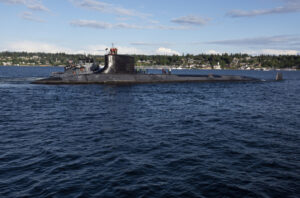A Navy official this week called the next-generation nuclear-powered attack submarine, SSN(X), an apex predator that will combine the best capability and technologies from three earlier designs.
“We are looking at the ultimate apex predator for the maritime domain. It is going to be faster, carry a significant punch, bigger payload, larger salvo rate, it’s going to have acoustic superiority and simultaneously we’re going to work on operational availability with respect to maintenance and life of the ship,” Rear Adm. Bill Houston, Director of the Undersea Warfare Division, N97, said July 21 during a pre-recorded Navy League SeaAirSpace Prequel discussion ahead of the main exposition next month.
Houston underscored the Navy plans to combine elements of what it has already created in other designs and put it in one new vessel.
He said they want to combine the speed and payload of the Seawolf-class attack submarine that entered into service in the late 1990s with the Virginia-class attack submarine acoustics and sensors and Columbia-class ballistic missile submarine operational availability and life of the ship.

Houston said these features are needed “because it really needs to be ready for that major combat operations, it’s going to need to go behind enemy lines and deliver that punch that is going to really, really establish our primacy. It needs to be able to deny an adversary their ability to operate in their bastion regions and that is what that platform is going to do.”
He said the Navy is confident they will be able to deliver on this because it has already delivered on the previous platforms or is delivering on the Columbia-class now.
“We know how to do that, we just have to mesh it together with one thing – one platform, and the systems we have with electronic design, tools, the stuff we’ve already developed – we’re going to capitalize on that.”
Houston noted that under the Navy’s current plans SSN(X) is timed to capitalize on the “very robust” Columbia-class design team and use them and then start ramping up production of SSN(X) just as Columbia is ramping down.
He said this will work because the Navy plans to have the design and research, development, test and evaluation (RDT&E) completed in time.
“It takes a significant amount of time and effort for that RDT&E to develop this apex predator, but that’s what we’re going to do over the next decade as we’re working on the systems for SSN(X),” Houston continued.
“But we’re very confident we can get there. It’s a daunting task, but the team is more than capable of doing it.”
President of General Dynamics Electric Boat [GD] Kevin Graney also spoke during a panel discussion and said that “we’d love to see those requirements get settled down so that we know exactly what we are designing.”
Graney agreed with the feeling but noted the Navy must finalize SSN(X) requirements in time to take advantage of using the Columbia design team on SSN(X).
“From my perspective we’ve just got a design team coming off of Columbia right now, so they’re a hot hand having just developed that and now’s the time to transition to the new SSN(X) design, we’re ready to go.”
GD Electric Boat is the incumbent prime contractor for the Columbia-class and the Virginia-class attack submarine. GD largely splits the work on Virginia-class production with Huntington Ingalls Industries [HII], which acts as a subcontractor.
Relatedly, Huston was optimistic about proposals to increase attack submarine production to potentially three boats per year on top of the Columbia-class, as long as that started after Columbia-class work was finished in the 2030s.
Last year, then-Secretary of Defense Mark Esper outlined the Battle Force 2045 future fleet plan that called for building three attack submarines per year to reach 355 traditional battle force ships before 2035 (Defense Daily, Oct. 6).
Houston said moving to three attack submarines per year is feasible even without significant shipyard investment, if the start of three hulls per year moves to when Columbia is ramping down.
“What our concern is, if you go to three per year to try to peak on submarines with Virginia being a 33-year life of ship platform, you start building three per year, you’re ending up with a force structure of 99.”
In contrast, the current requirement for the Navy is for about 70 submarines.
“So as we’re reconstituting Columbia and building two Virginias per year, when the last Columbia hull is delivered or even actually commences construction in ‘35, we’re going to have significant capacity then.”
Houston said the shipyards currently have the capacity to produce three Virginia-class submarines per year, but “the issue is that we’ve got Columbia under construction so we’re just doing that balancing right now.”
He said the Navy is trying to work with industry to avoid peaks and troughs or the boom and busy cycle in production for workforce and investment stability. “We’re sure that when Columbia, that last hull is under construction, we’re going to have significant capacity.”
“When you take a look at a Virginia Block 5 it’s about 10,000 tons. It’s about half of Columbia right now. So every Columbia that’s being constructed is really the equivalent in size of two Virginias. So right now, with the first hull under construction and two Virginias being appropriated and authorized this year, we’re essentially building four equivalent Virginias so the capacity is there, so [it’s] more about stability and avoiding the peak-troughs,” Houston said.